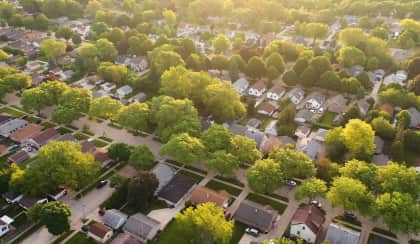‘Abnormal’ spring selling season unfolds as distressed sales surge
It’s turning out to be an unusual spring for Australia’s property market, as new data showed distress sales jumped while property listings declined last month.

The latest data from SQM Research showed total property listings declined by 2.5 per cent over the month — a sight rarely seen for October, when spring selling activity typically hits its highest level.
All capital cities, bar Hobart, recorded declines in property listings on a monthly basis, with Sydney and Darwin posting the biggest declines among their peers, with falls of -4.6 per cent and -4 per cent, respectively.
Compared to October 2021, total residential property listings across the country are also down by 1.6 per cent.
New listings — or properties added on the market over the last 30 days — rose at a modest rate of 1.6 per cent during the month.
SQM managing director Louis Christopher said the subdued rise in new listings was divergent from seasonal trends.
“This is abnormal given October is a month where the annual spring selling season reaches a peak in activity,” he commented,
Despite the nationwide increase in fresh stock, the trend for new listings widely varied across each capital city.
Sydney and Darwin tallied the steepest drops in new listings at 2.3 per cent and 5 per cent, respectively.
On the opposite side of the spectrum, Perth and Canberra were the biggest monthly gainers, with the West Australian capital recording a 4.4 per cent increase and the ACT capital notching a 2.9 per cent rise in new listings during the period.
Meanwhile, old listings, which refer to properties that have been on the market for more than 180 days, fell by 0.9 per cent month-on-month, weighed down by the 7 per cent slump in Adelaide.
According to Mr Christopher, older stock declined during the month due to higher absorption rates in regional Australian markets.
“However, it should be noted there were rises recorded in older stock for most of the capital cities, indicating city vendors struggled to move their property over the month,” he pointed out.
In another upending of spring selling trends, he also called attention to the new rise in distressed sales activity during the month.
Data showed that a total of 6,658 residential properties nationwide were selling under distressed conditions over October.
The 5.7 per cent monthly increase was largely driven by NSW and Queensland, where distressed listings jumped by more than 7 per cent.
“This may indicate the rising interest rate environment is starting to bite,” Mr Christopher said.
With the Reserve Bank of Australia hiking the country’s official cash rate by 25 basis points to 2.85 per cent during its November policy meeting, mortgage holders are warned to brace for more rate pains that may ultimately force some property owners to unload their property.
“Overall, it was a disappointing month for sellers and their respective agents in the capital cities — sellers would be wise to meet the market in this environment if they want to sell,” he concluded.
